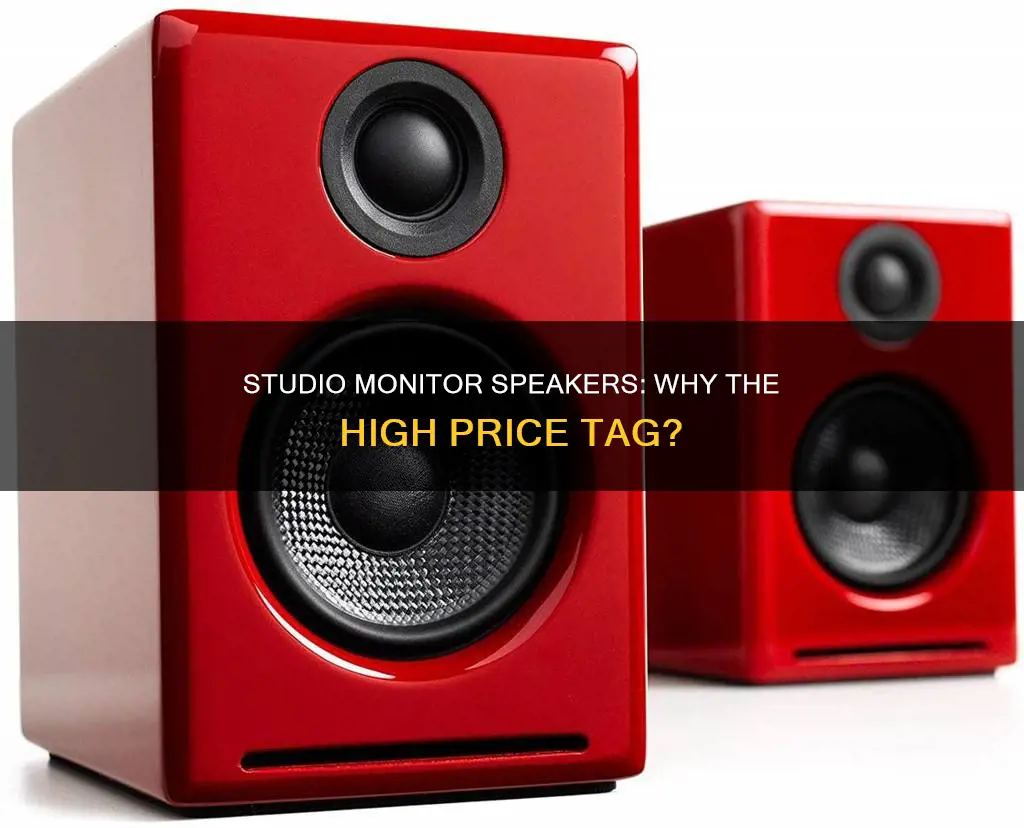
Studio monitors are an essential component of any recording studio, and their quality can significantly impact the final product. While it is possible to create music without them, investing in high-end studio monitors can elevate your recordings to the next level. The price of studio monitors can vary widely, from a few hundred to tens of thousands of dollars, and the justification for this price difference lies in the science and engineering behind these speakers.
Studio monitors are designed to provide an honest and accurate representation of your mix, ensuring that what you hear in the studio is what your listeners will hear. This level of transparency and flat frequency response is challenging to achieve and requires meticulous design, engineering, and calibration. Cheap monitors may enhance the bass or colour the sound, leading to mixes that sound great on those speakers but fall flat on other systems.
Additionally, more expensive studio monitors offer a wider range of frequencies, both within and beyond the human hearing range. They also boast top-notch designs, with innovations that create a wider sweet spot for more accurate listening and mixing. The quality of the materials used in construction, such as the speaker cones and cabinets, can impact the accuracy and speed of the speaker's response, reducing the risk of distortion.
While it is not necessary to spend a fortune on studio monitors, especially for beginners, investing in higher-quality monitors can provide a more accurate and detailed listening experience, making it easier to create exceptional mixes.
| Characteristics | Values |
|---|---|
| Science and technology | Studio monitors are built with advanced science and technology to ensure an accurate sound. |
| Parts and labour | Studio monitors are made with high-quality parts and come with hours of labour behind them. |
| Calibration | Studio monitors are calibrated to deliver an accurate representation of the music. |
| Range of frequencies | Studio monitors with a wider range of frequencies are more expensive. |
| Design | Studio monitors with top-notch design and a wider sweet spot are more expensive. |
| Transient response | Studio monitors with better transient response are more expensive. |
| Room correction | Studio monitors with room correction technology are more expensive. |
What You'll Learn

High-end studio monitors are more honest
Studio monitors are speakers designed for critical listening during music production and mixing. They are meant to let you hear your source audio in its rawest, purest, most uncoloured and transparent form. The frequency response of studio monitors is flat, meaning there is no artificial boosting or cutting of any frequencies. This means that if you can get a mix sounding great on some pro studio monitors, it will sound good everywhere.
The cost of studio monitors comes down to the science. Manufacturers spend years designing speaker models with an honest frequency response. You are paying for the hours of labour behind the monitors, the testing and calibration, the necessary parts to ensure they are top quality, and the work of the best engineers and machinery.
High-end studio monitors are more likely to be placed in multi-million-dollar studios and used by top producers. They are a worthwhile investment, as they will make mixing easier from a technical standpoint.
Dismantling a Monitor: Removing the Base Stand Safely
You may want to see also

They have a wider range of frequencies
Studio monitors are incredibly valuable because they are what you test your mixes on. You want speakers that are going to give you an accurate sound, with everything you designed and mixed in readily accessible to the ear.
Studio monitors can have a wider range of frequencies. The wider the range of frequencies, the better. Great speakers will go down to the depths of human hearing (20Hz) and up to frequency levels that far exceed human hearing.
The extra cost comes in two main forms, both related to the drivers, the circular parts that shunt those frequencies at you. The lower the frequency, the larger the bass driver tends to be, so the bigger the speaker.
Some speakers get away from being massive – and still deliver a great bottom end – by being connected to an additional large subwoofer box, which can be handily placed out of the way. This extends the bass further down and can be placed centrally in the system.
The other extended driver feature is simply having three of them per speaker, rather than the two that you will find on cheaper systems. The third tends to be a mid-driver that delivers mid-range frequencies.
That's not to say 2-way systems don't cover this but some sets might have a dip in the middle part of their frequency range, and a 3-way set of speakers evens this out by joining the dots between the woofer (low frequency) and tweeter (high frequency) drivers. 3-way speakers tend to deliver the whole picture. The third driver also means that the woofer and tweeter don't overlap in terms of their frequency response – the crossover frequency range – which means less phasing between the two (unwanted peaks and dips in the speaker’s total response).
Performance Monitor: Licensing Requirements for Running the Software
You may want to see also

They have a top-notch design
Studio monitor speakers are expensive because they have a top-notch design. The design of the cabinet and the placement of the drivers are carefully considered to ensure the most accurate listening experience over a wide space.
The sweet spot of a set of speakers is the point at which the speakers perform at their most accurate. Studio monitor speakers are designed to deliver a wider sweet spot so that more people can monitor, or the listener has greater freedom in their listening position.
One such innovation is the dual-centric or coaxial design, where one driver is placed over another so that they sit on the same acoustic axis. This means that as the listener moves around, they experience less off-axis coloration, and there is a wider position in which they can listen accurately to their mixes.
Other cabinet designs can also help reduce phasing by dispersing and directing certain frequencies. Baffle designs, for example, help to reduce phasing by dispersing sound waves and preventing them from combining and causing destructive interference.
In addition, the materials used in the construction of studio monitor speakers are often more durable and expensive. Speaker cones might be made from tough and non-flabby materials, and speaker cabinets are made with stiff materials so that the box doesn't vibrate or resonate at particular frequencies.
Asus Monitor Cleaning: A Step-by-Step Guide
You may want to see also

They have better and faster transients
Studio monitors are incredibly valuable because they are what you test your mixes on. You want speakers that are going to give you an accurate sound, with everything you designed and mixed in readily there and accessible to the ear. Studio monitors are the single most important investment you can make for your recording studio.
Studio monitors are designed to handle transient response. This is the time it takes for a speaker to react to the voltage of the sound being put through it. If a speaker has a good, tight transient response, it will follow the sound accurately and speedily. If not, it will be flabby, slow, and possibly distort at high levels as the cone moves too much.
Speaker cones might be made of durable, tough, and 'non-flabbiness-inducing' material, which is often expensive. The same goes for the speaker cabinets, which are made with stiff material so the box doesn't vibrate or resonate at particular frequencies. This also helps the transient response.
An extension of this is the speaker stand or acoustic isolator, which can help reduce vibration.
How to Identify Your Monitor: LCD or CRT?
You may want to see also

They can compensate for a terrible room
Studio monitors are an essential component of any recording studio, and their cost can vary significantly, ranging from a few hundred to tens of thousands of dollars. While it is not necessary to invest in the most expensive monitors, there are several reasons why they tend to be pricey. One factor is the level of accuracy they offer. High-end monitors provide an honest representation of your mix, revealing any issues that may exist. Cheaper alternatives may enhance the bass or colour the sound, leading to a mix that sounds bass-light on other systems.
The quality of studio monitors is also reflected in their frequency response and range. Superior monitors will deliver a wider frequency range, including frequencies beyond the scope of human hearing. This extended range influences the actual frequencies we can hear, enhancing the overall impact of the sound. Additionally, more expensive monitors tend to have multiple drivers, improving the overall sound quality and ensuring a more comprehensive frequency response.
The design of studio monitors also contributes to their cost. Modern monitors are designed to deliver a wider "sweet spot," maximising the listening position and freedom. This is achieved through innovations like the dual-centric or coaxial design, where one driver is placed over the other, reducing off-axis coloration and widening the accurate listening area.
Another critical aspect of studio monitors is their transient response, which refers to how quickly the speaker reacts to the voltage of the sound. High-end monitors with superior transient response will accurately follow the sound, ensuring speed and precision. This is achieved through the use of durable and expensive materials for the speaker cones and cabinets, minimising vibration and resonance.
Lastly, room acoustics play a significant role in the performance of studio monitors. Even the most accurate speakers can be affected by the acoustics of the room, as sound reflects off the walls and reaches the listener at different times. More expensive monitors often feature built-in calibration systems, allowing them to adjust their response characteristics based on the room's acoustics. This ensures that the monitors can compensate for less-than-ideal room conditions and still deliver an accurate representation of the music.
In conclusion, while studio monitors can be expensive, the investment is justified by their accuracy, frequency response, design innovations, transient response, and ability to compensate for less-than-perfect room acoustics. These features ensure that music producers and audio engineers can trust the sound they hear and make informed decisions during the mixing and mastering process.
LCD vs LED Monitors: Which is More Common?
You may want to see also
Frequently asked questions
Studio monitor speakers are an investment and can cost thousands of dollars. The price is justified by the science and engineering behind the product. They are designed to deliver an accurate, flat frequency response and to be honest in their representation of the mix.
A flat frequency response means that no frequencies are artificially boosted or cut. This allows the listener to hear the source audio in its rawest, purest, most uncoloured and transparent form.
The design of a studio monitor is important as it determines the listening experience and accuracy of the speaker over a wide space. The size of the speaker and the number of drivers it has will impact the frequency range and the bass response.
A sweet spot is the point at which the studio monitor performs at its most accurate. A wide sweet spot means that more people can monitor the mix accurately, and there is greater freedom in the listening position.







